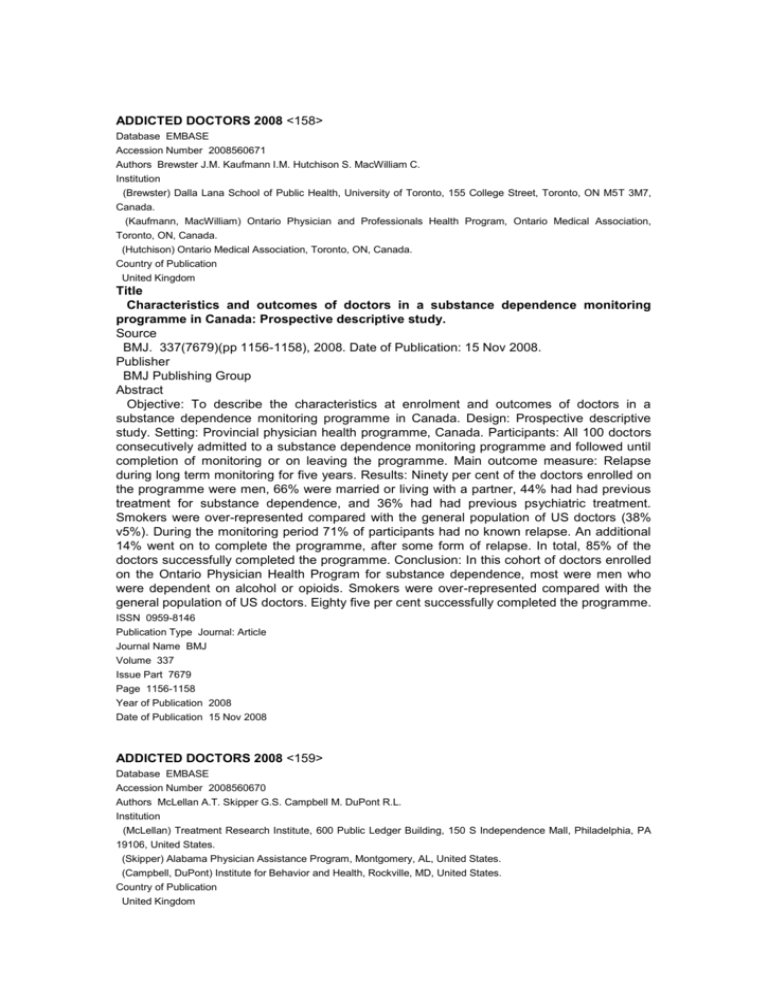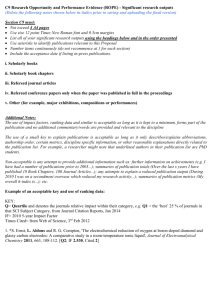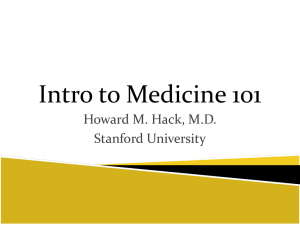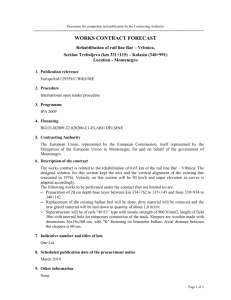
ADDICTED DOCTORS 2008 <158>
Database EMBASE
Accession Number 2008560671
Authors Brewster J.M. Kaufmann I.M. Hutchison S. MacWilliam C.
Institution
(Brewster) Dalla Lana School of Public Health, University of Toronto, 155 College Street, Toronto, ON M5T 3M7,
Canada.
(Kaufmann, MacWilliam) Ontario Physician and Professionals Health Program, Ontario Medical Association,
Toronto, ON, Canada.
(Hutchison) Ontario Medical Association, Toronto, ON, Canada.
Country of Publication
United Kingdom
Title
Characteristics and outcomes of doctors in a substance dependence monitoring
programme in Canada: Prospective descriptive study.
Source
BMJ. 337(7679)(pp 1156-1158), 2008. Date of Publication: 15 Nov 2008.
Publisher
BMJ Publishing Group
Abstract
Objective: To describe the characteristics at enrolment and outcomes of doctors in a
substance dependence monitoring programme in Canada. Design: Prospective descriptive
study. Setting: Provincial physician health programme, Canada. Participants: All 100 doctors
consecutively admitted to a substance dependence monitoring programme and followed until
completion of monitoring or on leaving the programme. Main outcome measure: Relapse
during long term monitoring for five years. Results: Ninety per cent of the doctors enrolled on
the programme were men, 66% were married or living with a partner, 44% had had previous
treatment for substance dependence, and 36% had had previous psychiatric treatment.
Smokers were over-represented compared with the general population of US doctors (38%
v5%). During the monitoring period 71% of participants had no known relapse. An additional
14% went on to complete the programme, after some form of relapse. In total, 85% of the
doctors successfully completed the programme. Conclusion: In this cohort of doctors enrolled
on the Ontario Physician Health Program for substance dependence, most were men who
were dependent on alcohol or opioids. Smokers were over-represented compared with the
general population of US doctors. Eighty five per cent successfully completed the programme.
ISSN 0959-8146
Publication Type Journal: Article
Journal Name BMJ
Volume 337
Issue Part 7679
Page 1156-1158
Year of Publication 2008
Date of Publication 15 Nov 2008
ADDICTED DOCTORS 2008 <159>
Database EMBASE
Accession Number 2008560670
Authors McLellan A.T. Skipper G.S. Campbell M. DuPont R.L.
Institution
(McLellan) Treatment Research Institute, 600 Public Ledger Building, 150 S Independence Mall, Philadelphia, PA
19106, United States.
(Skipper) Alabama Physician Assistance Program, Montgomery, AL, United States.
(Campbell, DuPont) Institute for Behavior and Health, Rockville, MD, United States.
Country of Publication
United Kingdom
Title
Five year outcomes in a cohort study of physicians treated for substance use
disorders in the United States.
Source
BMJ. 337(7679)(pp 1154-1156), 2008. Date of Publication: 15 Nov 2008.
Publisher
BMJ Publishing Group
Abstract
Objective: To evaluate the effectiveness of US state physician health programmes in treating
physicians with substance use disorders. Design: Five year longitudinal cohort study. Setting:
Purposive sample of 16 state physician health programmes in the United States. Participants:
904 physicians consecutively admitted to one of the 16 programmes from September 1995 to
September 2001. Main outcome measures: Completion of the programme, continued alcohol
and drug misuse (regular urine tests), and occupational status at five years. Results: 155 of
802 physicians (19.3%) with known outcomes failed the programme, usually early during
treatment. Of the 647 (80.7%) who completed treatment and resumed practice under
supervision and monitoring, alcohol or drug misuse was detected by urine testing in 126
(19%) over five years; 33 (26%) of these had a repeat positive test result. At five year followup, 631 (78.7%) physicians were licensed and working, 87 (10.8%) had their licences
revoked, 28 (3.5%) had retired, 30 (3.7%) had died, and 26 (3.2%) had unknown status.
Conclusion: About three quarters of US physicians with substance use disorders managed in
this subset of physician health programmes had favourable outcomes at five years. Such
programmes seem to provide an appropriate combination of treatment, support, and
sanctions to manage addiction among physicians effectively.
ISSN 0959-8146
Publication Type Journal: Article
Journal Name BMJ
Volume 337
Issue Part 7679
Page 1154-1156
Year of Publication 2008
Date of Publication 15 Nov 2008
ADDICTED DOCTORS 2008 <161>
Database EMBASE
Accession Number 2008562059
Authors McBeth B.D. Ankel F.K. Ling L.J. Asplin B.R. Mason E.J. Flottemesch T.J. McNamara R.M.
Institution
(McBeth) Department of Emergency Medicine, San Francisco General Hospital/University of California, San
Francisco, CA, United States.
(Ankel, Asplin, Mason, Flottemesch) Department of Emergency Medicine, Regions Hospital, St. Paul, MN, United
States.
(Ling) Department of Emergency Medicine, Hennepin County Medical Center, Minneapolis, MN, United States.
(McNamara) Department of Emergency Medicine, Temple University Medical Center, Philadelphia, PA, United
States.
Country of Publication
United Kingdom
Title
Substance use in emergency medicine training programs.
Source
Academic Emergency Medicine. 15(1)(pp 45-53), 2008. Date of Publication: January 2008.
Publisher
Blackwell Publishing Ltd
Abstract
Objectives: To explore the prevalence of substance use among emergency medicine (EM)
residents and compare to a prior study conducted in 1992. Methods: A voluntary, anonymous
survey was distributed in February 2006 to EM residents nationally in the context of the
national in-service examination. Data regarding 13 substances, demographics, and
perceptions of personal patterns of substance use were collected. Results: A total of 133 of
134 residencies distributed the surveys (99%). The response rate was 56% of the total EM
residents who took the in-service examination (2,397 / 4,281). The reported prevalence of
most illicit drug use, including cocaine, heroin, amphetamines, and other opioids, among EM
residents are low. Although residents reporting past marijuana use has declined (52.3% in
1992 to 45.0% in 2006; p < 0.001), past-year use (8.8%-11.8%; p < 0.001) and past-month
use (2.5%-4.0%; p < 0.001) have increased. Alcohol use appears to be increasing, including
an increase in reported daily drinkers from 3.3% to 4.9% (p < 0.001) and an increase in
number of residents who indicate that their consumption of alcohol has increased during
residency (from 4% to 12.6%; p < 0.001). Conclusions: Self-reported use of most street drugs
remains uncommon among EM residents. Marijuana and alcohol use, however, do appear to
be increasing. Educators should be aware of these trends, and this may allow them to target
resources for impaired and at-risk residents. copyright 2008 by the Society for Academic
Emergency Medicine.
ISSN 1069-6563
Publication Type Journal: Article
Journal Name Academic Emergency Medicine
Volume 15
Issue Part 1
Page 45-53
Year of Publication 2008
Date of Publication January 2008
ADDICTED DOCTORS 2008 <337>
Database EMBASE
Accession Number 2008380151
Authors Firth-Cozens J.
Institution
(Firth-Cozens) London Deanery, Stewart House, 32 Russell Square, London WC1B 5DN, United Kingdom.
Country of Publication
United Kingdom
Title
Doctors with difficulties: Why so few women?
Source
Postgraduate Medical Journal. 84(992)(pp 318-320), 2008. Date of Publication: June 2008.
Publisher
BMJ Publishing Group
Abstract
The National Clinical Assessment Service (NCAS), an NHS organisation that assesses
doctors and dentists referred to them because of perceived difficulties, has produced a report
describing data arising from its first 4 years, showing that male doctors were referred to the
service considerably more often than female doctors. Despite women accounting for 42% of
the general practitioner medical workforce and 37% of the medical hospital and community
(H&C) workforce in 2004, only 13% of GPs and 20% of H&C NCAS referrals were women.
When the H&C data were split into specialties, women were underrepresented proportionally
in all specialties. This paper offers a review of possible reasons for these gender differences
and in doing so contributes to the debates concerning problems in performance and also the
costs of employing a growing proportion of women doctors. Firstly, it hypothesises that the
NCAS data may be nonrepresentative of similar agency data, but finds that in disciplinary
organisations of various types around the world, men are consistently over-represented.
Secondly, it suggests that perhaps men are referred to such agencies more often than
women because their employers are more lenient on women. There is no evidence for this,
and it requires primary research to investigate it further. Finally, it considers gender
differences in the attributes, beyond technical skills, that underpin a good doctor-patient
relationship and finds that, on these attributes, women usually excel over men. In addition, far
fewer women are disciplined for addiction. The implications of this for education and
rehabilitation are considered. It concludes that any analysis of the economic costs of
employing a greater proportion of female doctors must take into account the higher costs of
men's litigation, discipline and retraining.
ISSN 0032-5473
Publication Type Journal: Short Survey
Journal Name Postgraduate Medical Journal
Volume 84
Issue Part 992
Page 318-320
Year of Publication 2008
Date of Publication June 2008
ADDICTED DOCTORS 2008 <355>
Database EMBASE
Accession Number 2008389369
Authors Marshall E.J.
Institution
(Marshall) National Addiction Centre, Institute of Psychiatry, King's College London, London, United Kingdom.
Country of Publication
United Kingdom
Title
Doctors' health and fitness to practise: Treating addicted doctors.
Source
Occupational Medicine. 58(5)(pp 334-340), 2008. Date of Publication: 2008.
Publisher
Oxford University Press
Abstract
The literature describing the diagnostic process in the addicted doctor is scant. Figures from
North America indicate that the prevalence of alcohol problems in doctors may be no higher
than in the population as a whole, whereas high rates of prescription drug use have been
recognized. This practice of self-treatment with controlled drugs is a 'unique concern' for
doctors. The development of substance misuse problems in doctors cannot be reduced to a
single factor: Anxiety and depression, personality problems, stress at work, family stress,
bereavement, an injury or accident at work, pain and a non-specific drift into drinking have
been implicated. Early diagnosis is critical because doctors are often reluctant to seek help
and colleagues reluctant to intervene. Medical schools and continuing medical education
programmes must give greater emphasis to addiction and substance misuse in doctors with a
view to reducing the incidence of 'impaired physicians' and promoting and encouraging early
treatment and rehabilitation. The relationship between the addiction psychiatrist and the
occupational physician is key given that these problems occur at the interface between
occupational health and regulatory systems. The need for individually tailored back to work
programmes requires careful coordination and monitoring and may be difficult to implement
without their involvement. Generally, the prognosis for doctors' recovery is good and it is
possible to predict which doctors will 'make it'. copyright The Author 2008. Published by
Oxford University Press on behalf of the Society of Occupational Medicine. All rights
reserved.
ISSN 0962-7480
Publication Type Journal: Review
Journal Name Occupational Medicine
Volume 58
Issue Part 5
Page 334-340
Year of Publication 2008
Date of Publication 2008
ADDICTED DOCTORS 2008 <431>
Database EMBASE
Accession Number 2008306809
Authors Merlo L.J. Gold M.S.
Institution
(Merlo, Gold) Department of Psychiatry, University of Florida,
(Merlo) University of Florida - Psychiatry, P.O. Box 100183, Gainesville, FL 32610-0183, United States.
Country of Publication
United Kingdom
Title
Prescription opioid abuse and dependence among physicians: Hypotheses and
treatment.
Source
Harvard Review of Psychiatry. 16(3)(pp 181-194), 2008. Date of Publication: May 2008.
Publisher
Routledge
Abstract
Physician impairment is a serious public health issue affecting physicians as well as their
families, colleagues, and patients. Though physicians generally display healthier habits than
members of the general population, overall rates of impairment are similar among both
groups, and prescription drug abuse (including prescription opioids) is particularly problematic
among physicians. The current review focuses mainly on prescription opioid abuse and
dependence among physicians. It includes a brief history of early physician experiences with
anesthetic and analgesic agents, and explores several hypotheses regarding the etiology of
prescription opioid abuse and dependence among physicians. Barriers to identification and to
treatment entry among physicians are discussed. In addition, methods of assessment and
successful treatment in specialized impaired physician programs are described. Medical and
psychosocial interventions, 12-step involvement, and extensive use of evaluations are
highlighted. Attention is paid to typical follow-up contracting and monitoring strategies, as well
as strategies for prevention. Given the extremely positive outcomes demonstrated by
specialized programs for treating impaired professionals, it is recommended that their
methods be disseminated and utilized in treatment centers for the general public. copyright
2008 President and Fellows of Harvard College.
ISSN 1067-3229
Publication Type Journal: Review
Journal Name Harvard Review of Psychiatry
Volume 16
Issue Part 3
Page 181-194
Year of Publication 2008
Date of Publication May 2008
ADDICTED DOCTORS 2006 <534>
Database EMBASE
Accession Number 2006581337
Authors Saunders D.
Country of Publication
United Kingdom
Title
Substance abuse and dependence in anaesthetists.
Source
Best Practice and Research in Clinical Anaesthesiology. 20(4)(pp 637-643), 2006. Date of
Publication: Dec 2006.
Abstract
The incidence of substance abuse amongst anaesthetists in the United Kingdom is
unknown. In the interests of patient safety, it is essential that the dependent doctor is
identified and entered into a treatment regime. No national strategy is in place to treat and,
where possible, return the anaesthetist in recovery to work. It is important therefore, that
individual employers have a standing operating procedure to deal with the addicted doctor. It
is essential that the initial approach is made by a competent panel, each of whom has
experience of dealing with dependent doctors. This is an extremely stressful time for the
doctor involved; it is therefore essential that active support is given. It is not always necessary
to suspend the doctor from work whilst treatment is undertaken. In the dependent doctor
sudden withdrawal of the substance of addiction can be life-threatening. It is therefore
essential that the supervising physician has specialist knowledge of the treatment of
addiction. Residential care probably provides the greatest hope of success. In the United
States, Canada, Australia and New Zealand 'impaired physician' programmes are in place
which allow some doctors to return to work, initially under strict supervision. Registration with
a self-help organisation is essential; a list of such groups in the United Kingdom is appended.
copyright 2006 Elsevier Ltd. All rights reserved.
ISSN 1521-6896
Publication Type Journal: Review
Journal Name Best Practice and Research in Clinical Anaesthesiology
Volume 20
Issue Part 4
Page 637-643
Year of Publication 2006
Date of Publication Dec 2006
ADDICTED DOCTORS 2008 <724>
Database Ovid MEDLINE(R) In-Process & Other Non-Indexed Citations and Ovid MEDLINE(R)
Unique Identifier 18984632
Status MEDLINE
Authors McLellan AT. Skipper GS. Campbell M. DuPont RL.
Authors Full Name McLellan, A Thomas. Skipper, Gregory S. Campbell, Michael. DuPont, Robert L.
Institution
Treatment Research Institute, 600 Public Ledger Building, 150 S Independence Mall, Philadelphia, PA 19106, USA.
tmclellan@tresearch.org
Title
Five year outcomes in a cohort study of physicians treated for substance use
disorders in the United States.
Source
BMJ. 337:a2038, 2008.
Journal Name
BMJ
Other ID
Source: NLM. PMC2590904
Country of Publication
England
Abstract
OBJECTIVE: To evaluate the effectiveness of US state physician health programmes in
treating physicians with substance use disorders. DESIGN: Five year, longitudinal, cohort
study. SETTING: Purposive sample of 16 state physician health programmes in the United
States. PARTICIPANTS: 904 physicians consecutively admitted to one of the 16 programmes
from September 1995 to September 2001. MAIN OUTCOME MEASURES: Completion of the
programme, continued alcohol and drug misuse (regular urine tests), and occupational status
at five years. RESULTS: 155 of 802 physicians (19.3%) with known outcomes failed the
programme, usually early during treatment. Of the 647 (80.7%) who completed treatment and
resumed practice under supervision and monitoring, alcohol or drug misuse was detected by
urine testing in 126 (19%) over five years; 33 (26%) of these had a repeat positive test result.
At five year follow-up, 631 (78.7%) physicians were licensed and working, 87 (10.8%) had
their licences revoked, 28 (3.5%) had retired, 30 (3.7%) had died, and 26 (3.2%) had
unknown status. CONCLUSION: About three quarters of US physicians with substance use
disorders managed in this subset of physician health programmes had favourable outcomes
at five years. Such programmes seem to provide an appropriate combination of treatment,
support, and sanctions to manage addiction among physicians effectively.
Publication Type Evaluation Studies. Journal Article. Multicenter Study. Research Support, Non-U.S. Gov't.
Date of Publication 2008
Year of Publication 2008
Volume 337
Page a2038
ADDICTED DOCTORS 2008 <749>
Database EMBASE
Accession Number 2008005545
Authors Da Silveira D.X. Rosa-Oliveira L. Di Pietro M. Niel M. Doering-Silveira E. Jorge M.R.
Institution
(Da Silveira, Rosa-Oliveira, Di Pietro, Niel, Doering-Silveira, Jorge) Addiction Unit (PROAD), Department of
Psychiatry, Federal University of Sao Paulo (UNIFESP), Brazil.
Country of Publication
United Kingdom
Title
Evolutional pattern of drug use by medical students.
Source
Addictive Behaviors. 33(3)(pp 490-495), 2008. Date of Publication: Mar 2008.
Abstract
Recent use of psychoactive substances among 456 medical students throughout the six
grades was surveyed by way of a self-report questionnaire using World Health Organisation
criteria. Among male medical students, the most frequently used substances were alcohol
(80.5%), cannabis (25.3%), solvents (25.2%), and tobacco (25.2%), whereas among female
students the most frequently used drugs were alcohol (72.6%), tobacco (14.6%), solvents
(10.5%), and tranquillizers (7.5%). Switch from illegal to legal drugs were observed only
among female medical students. Male students tend to alternate cannabis and solvents
throughout college years. Interventions aiming to influence patterns of drug consumption
among medical students must consider both gender differences and evolutional patterns of
substance use throughout medical course. copyright 2007.
ISSN 0306-4603
Publication Type Journal: Article
Journal Name Addictive Behaviors
Volume 33
Issue Part 3
Page 490-495
Year of Publication 2008
Date of Publication Mar 2008







